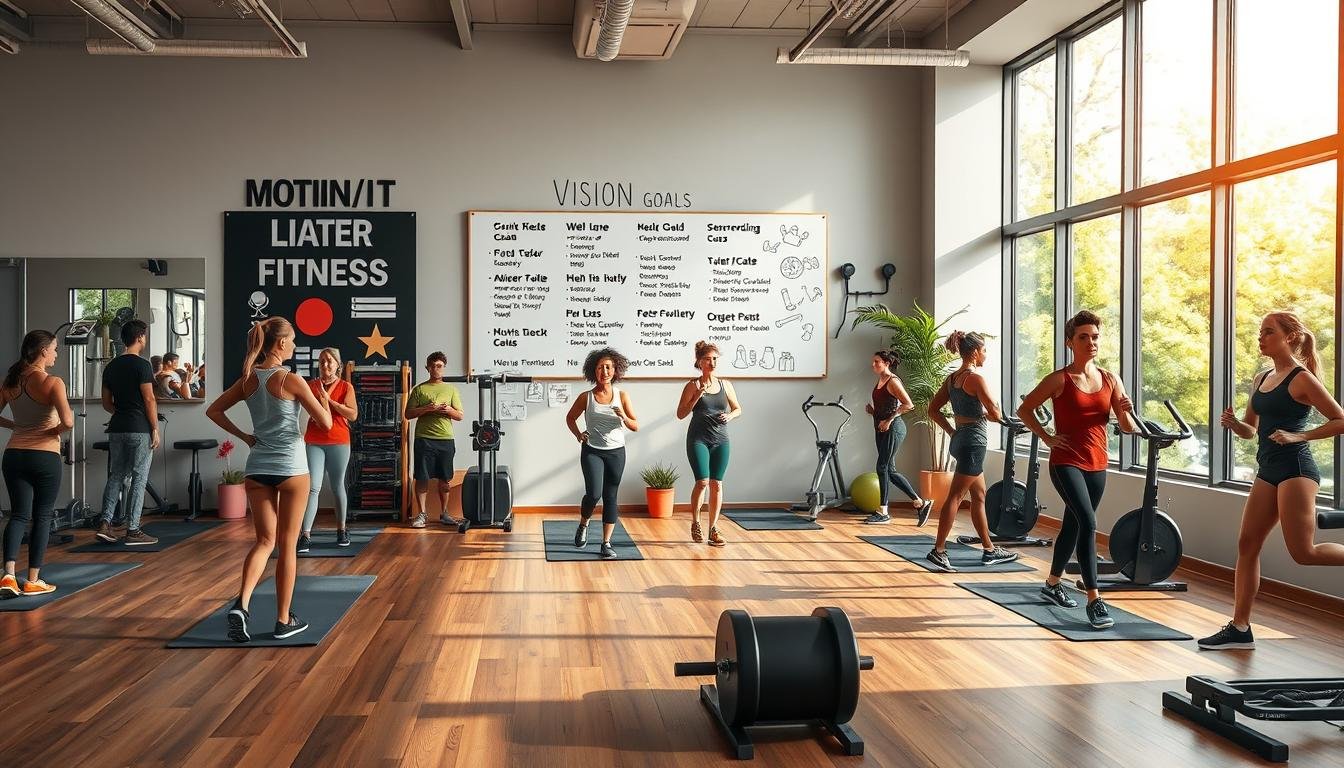Learning how to set realistic fitness goals is key for lasting success. By setting achievable targets, you can make your wellness journey sustainable. This guide helps you focus on self-awareness, measurable progress, and adaptable goals. This way, your fitness journey will be both effective and enjoyable.
Setting fitness goals that match your current abilities is essential for lasting progress. Whether you’re a fitness enthusiast or just starting, knowing your baseline and setting SMART objectives is important. With the right mindset and strategies, you’ll reach your fitness goals this year.
Understanding Fitness and Your Personal Starting Point
Starting a fitness journey without knowing where you are is like sailing without a map. It’s important to evaluate your current fitness level first. This includes checking your endurance, strength, flexibility, and body composition. It gives you a starting point to track your progress.
Simple tests like measuring resting heart rate, doing the plank test, and counting bodyweight squats can help. These tests show what you can do physically. It’s better to focus on your own abilities than compare with others. This way, your fitness plan will be made just for you, helping you grow in a healthy way.
Know Your Current Fitness Level
Knowing where you start is key to setting achievable goals and making a good fitness plan. By assessing your cardio health, measuring muscular strength, and testing your flexibility, you learn a lot about your fitness. This helps you understand your overall fitness level.
Tips on Evaluating Your Fitness Level
Begin by recording your resting heart rate to see how your heart is doing. Do a plank test to check your core strength and endurance. Count how many bodyweight squats you can do to see your lower body strength. Lastly, try a flexibility test like the sit-and-reach to analyze your body composition and how flexible you are.
By taking the time to understand your personal starting point, you can set goals that are reachable. You can then make a plan that’s just right for you, helping you make steady progress.
Setting Your Fitness Goals
Starting a fitness journey needs a clear plan. That’s where SMART fitness goals come in. This method makes your goals clear, trackable, and reachable. It’s great for fitness lovers, helping them plan their physical growth.
Understanding SMART Goals
Make sure your fitness goals fit the SMART criteria. Goals should be specific, like running a 5K or doing a certain number of push-ups. They must be measurable, so you can see your progress. Goals should also be achievable, match your personal goals, and have deadlines.
Examples of Realistic Fitness Goals for Beginners
For beginners, starting with easy fitness goals is a good idea. You might aim to mix cardio and strength training, improve flexibility with stretching or yoga, or boost endurance. These specific goals help you stay focused and enjoy your fitness journey.
Success in fitness comes from a SMART approach. Clear, trackable, and reachable goals help you reach your fitness dreams. This way, you can keep a healthy and active lifestyle.
Creating a Tailored Fitness Plan
Creating a workout plan that fits you is key to reaching your fitness goals. It should be fun and match your lifestyle. For example, if you want to get stronger, focus on strength training exercises. If you want to boost your cardiovascular health, mix in aerobic activities and interval training.
Developing a Personalized Workout Plan
A good plan includes a variety of exercises to keep things interesting. It’s also important to balance your workouts. This means giving your body time to recover, which is vital after intense workouts.
Experts say the right workout frequency depends on your goals:
| Goal | Cardiovascular | Strength/Resistance | Flexibility |
|---|---|---|---|
| Weight Loss and Endurance | 3-5 days/week | 2-3 days/week | 5 days/week |
| Muscle Growth | 3-5 days/week | 2-4 days/week | 5 days/week |
| Weight Maintenance, Health | 3-5 days/week | 2-3 days/week | 5 days/week |
The Role of Variety and Balance
Check your workout plan every 2-4 weeks to see if it’s working. Make changes as needed to keep moving towards your goals. A balanced fitness routine that includes cardiovascular, strength, and flexibility training is essential for overall fitness and well-being.
Staying Flexible with Your Goals
In the world of fitness, being too rigid can hold you back. As you get stronger, your fitness goals might become too hard or too simple. It’s key to recognize and accept this shift.
Being flexible with your goals lets you adapt fitness goals, reassess progress, and modify workout plans. This way, you can keep up with your abilities and dreams.
Your body’s signals are important in this journey. They tell you when you’re tired, uncomfortable, or in pain. This might mean it’s time to reassess your approach. Changing your goals is not a setback. It’s a smart move to keep growing, motivated, and safe from injury.
By being flexible, you start a sustainable fitness journey. It changes with you, meeting your evolving needs and abilities.
Fitness isn’t for everyone in the same way. Stay open, listen to your body, and adjust your workouts as needed. This flexibility helps you reach your goals and keeps you enjoying the journey.
How to Set Realistic Fitness Goals This Year
Setting realistic fitness goals is key for a sustainable wellness journey. Experts say to focus on one goal at a time. Make sure your goals match your interests and lifestyle. Start with small, achievable milestones.
By taking a long-term approach, you build a healthy fitness relationship. This way, you avoid the trap of setting too high goals or getting burned out.
To set practical guide to goal-setting, first check your current fitness level. Think about your daily activity, strength, and endurance. Use this info to set a baseline.
Then, set SMART (Specific, Measurable, Achievable, Relevant, and Time-bound) goals. These should challenge you but not be too hard.
Always listen to your body and tweak your goals if needed. Celebrate every small success, like trying a new exercise or taking more steps. By doing this, you’re on the path to a long-term fitness mindset and a sustainable wellness journey.
| Tips for Setting Realistic Fitness Goals | Benefits of Realistic Goal-Setting |
|---|---|
|
|
The Importance of Listening to Your Body
Listening to your body is key when you’re active. It means paying attention to signs of tiredness, discomfort, or pain. Understanding these signals helps you adjust your workout to avoid injuries.
Ignoring these signs can lead to injuries. But, by making the right changes, you can keep your fitness journey on track. This way, you can stick to sustainable fitness practices.
Being aware of your body helps you spot signs of fatigue and tweak your workout routines. This approach prevents injuries and makes sure you use your time and energy wisely. It also helps you find the right balance between pushing yourself and resting.
This balance is key for consistent and effective fitness progress.
Getting to know your body’s signals takes time and effort. But, the rewards are huge. It’s about more than just knowing when to stop eating or recognizing pain. It’s about being fully present in your workouts and caring for your body.
This mindset can change your fitness journey for the better. It leads to better health and wellness in the long run.
Work on One Goal at a Time
Reaching your fitness goals is easier when you focus on one thing at a time. Experts say it’s better to stick to a consistent gym routine or diet change. This way, you build lasting fitness habits for your health.
Personalize Your Goals
It’s important to make your fitness goals your own. Choose activities and workouts you really enjoy. This makes it easier to stick to your plan and set goals that feel right for you.
Success comes from taking things slowly. By focusing on one fitness goal at a time, you avoid getting overwhelmed. This helps you make steady progress towards your health goals.
Start Small and Be Patient
When you set fitness goals, start with small, achievable steps. This way, you’re more likely to succeed and build confidence in your abilities. Don’t set goals that are too high, as this can make you feel discouraged and lose motivation.
Instead, aim for small, incremental steps that slowly get you closer to your fitness dreams. Remember, lasting changes take time. So, embrace a long-term mindset and celebrate each small win you make. This approach will not only help you reach your goals but also make the journey enjoyable.
Research shows that 80% of New Year’s resolutions fail by February. This is often because people set unrealistic goals or lose motivation. By starting small and being patient, you can boost your chances of success and maintain motivation on your fitness journey.
| Achievable Fitness Goals | Realistic Timeline |
|---|---|
| Run a 5k race in under 30 minutes | By the end of March |
| Lose 1-2 pounds per week | Ongoing |
| Increase daily water intake to 8 glasses | Within the first month |
The secret to success is to start small, be patient, and celebrate your progress. By taking a sustainable approach to your fitness goals, you’ll be well on your way to achieving your long-term aspirations.
Conclusion
Setting realistic fitness goals is key to a successful wellness journey. Knowing your current fitness level and creating SMART goals helps. A personalized workout plan makes your fitness fit your life.
Being flexible and listening to your body is important. Focus on one goal at a time to stay motivated. This helps avoid burnout.
Start small and be patient. Enjoying the journey leads to lasting health improvements. The tips in this article will help you reach your fitness goals.
Tracking your progress is essential for success. Celebrate your achievements along the way. Clear goals and a plan help you stay on track.
Building healthy habits and having support boosts motivation. These steps make reaching your fitness goals more achievable.





